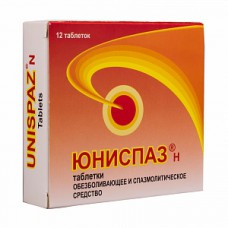Expiration date: 05/2025
Composition and form of issue:
Tablets. 1 tablet contains:
paracetamol 500 mg
drotaverine hydrochloride 40 mg
codeine phosphate 8 mg
excipients: corn starch jam starch corn starch corn starch pre-gelatinized magnesium stearate talc purified crosspovidone MCC dye iron oxide red
in blistere 6 PCs., in box 2 blisters.
Description of dosage form:
Tablets brownish-pink with dark and light patches, oblong, with a risk on one side.
Characteristic:
Spatioenergetic. Combined drug, the effect of which is due to its constituent components.
Pharmacokinetics:
Suction and distribution
After taking the drug inside paracetamol is rapidly absorbed from the gastrointestinal tract, distributed in most organs and tissues of the body.
Codeine is rapidly absorbed into the gastrointestinal tract, distributed in most organs and tissues, mainly — in parenchymal organs (liver, spleen, kidneys).
Penetrates the BBB, placental barrier, excreted in breast milk.
Metabolism and excretion
Paracetamol is metabolized primarily by conjugation followed by excretion in the urine. T1/2 paracetamol-from 1, 25 to 3 no. About 85% of the dose is excreted within 24 no.
T1/2 codeine is about 2, 9 h. report mostly in the urine. About 90% of the dose is excreted within 24 hours.
Description of pharmacological action:
Paracetamol has analgesic and antipyretic effect mainly by inhibiting the synthesis of PG in the Central nervous system and to a lesser extent — by peripheral action, blocking PG and other active substances that stimulate pain receptors.
Drotaverine is a derivative of isoquinoline, and has antispasmodic effect on smooth muscles by inhibiting phosphodiesterase 4, the increase in camp concentration, which, inactivating mythinking, leads to relaxation of smooth muscle. Also drotaverine has a weak inhibitory effect on kolmogorovsky calcium channels. Regardless of the type of Autonomous innervation, drotaverine is effective for smooth muscle spasms. It acts on smooth muscles located in the vascular, gastrointestinal, biliary and urogenital systems (the content of phosphodiesterase 4 in different tissues is different).
Codeine has analgesic effect through interaction with opioid receptors involved in the transmission of pain impulses in the Central nervous system, potentiates analgesic effect of paracetamol, has a Central antitussive effect.
Indications:
Pain syndrome of weak and moderate intensity, caused including spasms of smooth muscles:
- toothache
- headache
- joint and muscle pain
- neuralgia
- sciatica
- algodismenorrhea
- renal colic
- spasms of the ureter and bladder
- biliary colic
- intestinal colic
- spastic constipation
- other spastic conditions of the internal organs.
Contraindications:
- hypersensitivity to the drug components
- severe renal failure
- severe liver failure
- severe heart failure
- AV blockade of II and III degree
- respiratory failure
- bronchial asthma
- glucose-6-phosphate dehydrogenase deficiency
- chronic alcoholism
- drug dependence
- status after TBI
- intracranial hypertension
- blood diseases (thrombocytopenia, leukopenia, agranulocytosis)
- simultaneous use of MAO inhibitors and within 14 days after their withdrawal
- the simultaneous administration of drugs containing paracetamol
- pregnancy
- lactation.
With caution:
- patients with constitutional hyperbilirubinemia (Gilbert's syndrome)
- elderly patients.
Use during pregnancy and breast-feeding:
The use of the drug Urispas during pregnancy and lactation is contraindicated. At the time of treatment should stop breastfeeding.
Side effect:
From the Central nervous system: headache, dizziness, drowsiness.
From the cardiovascular system: hypotension, tachycardia, tides.
From the digestive system: nausea, constipation rarely when used in high doses — toxic liver damage.
From the hematopoietic system: agranulocytosis, thrombocytopenia.
Allergic reactions: skin rash is very rare-bronchospasm, swelling of the nasal mucosa.
Drug interaction:
Drotaverine reduces the effect of levodopa, which makes it possible to increase tremor and rigidity.
When using paracetamol together with drugs that cause the induction of liver enzymes (salicylamide, barbiturates, antiepileptic agents, tricyclic antidepressants, rifampicin, alcohol), the concentration of toxic metabolites of paracetamol increases.
When using paracetamol simultaneously with chloramphenicol increases the half-life of the latter and increases its toxicity.
Simultaneous use of paracetamol with doxorubicin increases the risk of liver function disorders.
Paracetamol reduces the effect of uricosuric drugs.
Metoclopramide and domperidone enhance the absorption of paracetamol, and its colestyramine reduces. With long-term use of the drug increases the risk of bleeding due to the presence of paracetamol.
Codeine increases the effect of sleeping pills,analgesic and sedative.
Dosage and administration:
Inside. Single dose-1-2 table. if necessary , repeat after 8 h To achieve a rapid effect the drug should not be taken with food.
In the course of treatment no more than 3 days maximum daily dose — 6 table. With a long course of treatment, the maximum daily dose is 4 tables. per day.
Children aged 6 to 12 years single dose-0, 5-1 table. Re-use is possible after 10-12 hours, the maximum daily dose - 2 tables. per day.
Elderly patients with normal liver and kidney function dose adjustment is not required.
In severe liver and kidney function dose should be reduced. At a glomerular filtration rate of less than 10 ml / min, the break between the two doses should be more than 12 hours.in this category of patients, only occasional use of the drug is allowed.
The maximum duration of treatment without consulting a doctor-3 days.
Overdose:
Symptoms: nausea, vomiting, circulatory disorders, respiratory depression, toxic liver damage (up to necrosis).
Treatment: gastric lavage, saline laxatives. In severe damage to the Central nervous system to monitor the condition may need ventilator, oxygen, naloxone.
Special instruction:
When using the drug, the patient should exclude the use of alcohol.
In renal and hepatic insufficiency dose should be set individually.
When using the drug for more than 3 days and/or in high doses, it is necessary to control the picture of peripheral blood and the functional state of the liver (the number of leukocytes, platelets, creatinine levels and activity of liver enzymes in blood plasma). Clinical symptoms of the hepatotoxic effect begin to appear within 48-72 hours after the use of the drug in high doses.
Impact on the ability to drive and operate machinery
The question of the possibility of employment activities that require increased concentration and speed of psychomotor reactions should be addressed after assessing the individual patient's reaction to the drug.
Unispaz
H
(Drotaverine
+
Paracetamol)
12
tablets
- Brand: Unique Pharmaceutical Lab

- Availability:
in stock
Categories:
-
$5.00

